
2021-11-10 12:20:00
OIL PRICES 2021-22: $82-$72
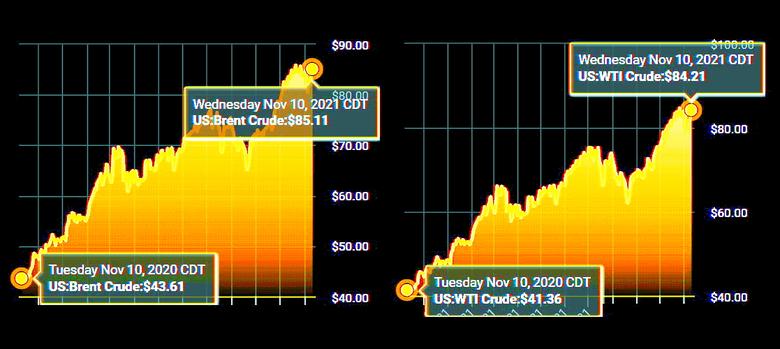
U.S. EIA - Nov. 9, 2021 - Short-Term Energy Outlook
Forecast highlights
Global liquid fuels
- The November Short-Term Energy Outlook (STEO) remains subject to heightened levels of uncertainty related to the ongoing recovery from the COVID-19 pandemic. U.S. gross domestic product (GDP) declined by 3.4% in 2020 from 2019 levels. This STEO assumes U.S. GDP will grow by 5.4% in 2021 and by 4.2% in 2022. The U.S. macroeconomic assumptions in this outlook are based on forecasts by IHS Markit. In addition to uncertainty about macroeconomic conditions, the evolving effects of consumer behavior on energy demand because of the pandemic present a wide range of potential outcomes for energy consumption. Supply uncertainty in the forecast results from the production decisions of OPEC+ along with the rate at which U.S. oil and natural gas producers increase drilling at forecast price levels.
- Brent crude oil spot prices averaged $84 per barrel (b) in October, up $9/b from September and up $43/b from October 2020. Crude oil prices have risen over the past year as result of steady draws on global oil inventories, which averaged 1.9 million barrels per day (b/d) during the first three quarters of 2021. In addition to sustained inventory draws, prices increased after OPEC+ announced in early October—and reaffirmed on November 4—that the group would keep current production targets unchanged. We expect Brent prices will remain near current levels for the rest of 2021, averaging $82/b in the fourth quarter of 2021. In 2022, we expect that growth in production from OPEC+, U.S. tight oil, and other non-OPEC countries will outpace slowing growth in global oil consumption and contribute to Brent prices declining from current levels to an annual average of $72/b.
- We estimate that 98.9 million b/d of petroleum and liquid fuels was consumed globally in October, an increase of 4.5 million b/d from October 2020 but 1.9 million b/d less than in October 2019. We revised up our forecast for consumption of petroleum and liquid fuels for the fourth quarter of 2021, partially as a result of fuel switching from natural gas to petroleum in the electric power sector in parts of Asia and Europe. This fuel switching is a result of increases in natural gas prices in Asia and Europe. We forecast that global consumption of petroleum and liquid fuels will average 97.5 million b/d for all of 2021, which is a 5.1 million b/d increase from 2020. We forecast that global consumption of petroleum and liquid fuels will increase by 3.3 million b/d in 2022.
- U.S. regular gasoline retail prices averaged $3.29 per gallon (gal) in October, up 12 cents/gal from September, and $1.13/gal higher than in October 2020. The October price was the highest monthly average since September 2014. We forecast that retail gasoline prices will average $3.32/gal in November before falling to $3.16/gal in December, which are 16 cents/gal and 11 cents/gal higher than our previous forecast, respectively.
- U.S. crude oil production averaged an estimated 11.4 million b/d in October, up from 10.7 million b/d in September as a result of production increases following disruptions from Hurricane Ida. We forecast production will rise to 11.6 million b/d in December. We forecast annual production will average 11.1 million b/d in 2021, increasing to 11.9 million b/d in 2022 as tight oil production rises in the United States. Growth will come largely as a result of onshore operators increasing rig counts, which we expect will offset production decline rates.
Natural Gas
- In October, the natural gas spot price at Henry Hub averaged $5.51 per million British thermal units (MMBtu), which was up from the September average of $5.16/MMBtu and up from an average of $3.25/MMBtu in the first half of 2021. The rising natural gas prices in recent months reflect U.S. natural gas inventory levels that are below the five-year (2016–20) average. Despite high prices demand for natural gas for electric power generation has remained relatively high, which along with strong global demand for U.S. liquefied natural gas (LNG) has limited downward natural gas price pressures.
- The Henry Hub spot price will average $5.53/MMBtu from November through February in our forecast and then generally decline through 2022, averaging $3.93/MMBtu for the year amid rising U.S. natural gas production and slowing growth in LNG exports. We forecast that U.S. inventory draws will be similar to the five-year average this winter, and we expect that factor, along with rising U.S. natural gas exports and relatively flat production through March, will keep U.S. natural gas prices near recent levels before downward price pressures emerge. Because of uncertainty around seasonal demand, we expect natural gas prices to remain volatile over the coming months with winter temperatures to be a key driver of demand and prices.
- We estimate that U.S. LNG exports averaged 9.8 billion cubic feet per day (Bcf/d) in October 2021, up 0.3 Bcf/d from September, supported by large prices differences between Henry Hub prices in the United States and spot prices in Europe and Asia. LNG exports resumed from Cove Point LNG in late October after that facility’s annual maintenance was completed. In our forecast LNG exports average 9.8 Bcf/d for all of 2021, up 50% from 2020. We expect that LNG exports will increase this winter, averaging 11.0 Bcf/d from November through March. We expect high levels of LNG exports to continue into 2022, averaging 11.5 Bcf/d for the year, up 17% from 2021. The forecast reflects our assumption that global natural gas demand remains high and several new natural liquefaction trains—the sixth train at Sabine Pass LNG and the first trains at the new LNG export facility, Calcasieu Pass LNG—enter service.
- U.S. natural gas inventories ended October 2021 at more than 3.6 trillion cubic feet (Tcf), 3% less than the five-year average for this time of year. Injections into storage this summer were below the previous five-year average, largely as a result of more electricity consumption in June because of hot weather and increased exports, even as domestic natural gas production has remained flat. However, in recent weeks, storage levels have moved closer to average levels as injections outpaced the fiveyear average in September and October. We expect natural gas inventories to fall by 2.1 Tcf this winter, ending March at 1.6 Tcf, which would be 4% less than the 2017–21 average for that time of year.
- We estimate dry natural gas production averaged 94.9 Bcf/d in the United States in October (up from 94.5 Bcf/d in September) and 91.9 Bcf/d in in the first half of 2021. Production in the forecast rises to an average of 95.2 Bcf/d during the rest of this winter (November–March) and averages 96.7 Bcf/d during 2022, driven by natural gas and crude oil prices, which we expect to remain at levels that will support enough drilling to sustain production growth.
Electricity, coal, renewables, and emissions
- The share of electricity generation produced by natural gas in the United States averages 36% in 2021 and 35% in 2022 in our forecast, down from 39% in 2020. In 2021, our forecast share for natural gas as a generation fuel declines in response to our expectation of a higher delivered natural gas price for electricity generators, which we forecast will average $5.12/MMBtu compared with $2.39/MMBtu in 2020. As a result of the higher expected natural gas prices, the forecast share of electricity generation from coal rises from 20% in 2020 to about 23% in 2021 and 22% in 2022. For renewable energy sources, new additions of solar and wind generating capacity are offset somewhat by reduced generation from hydropower this year, resulting in the forecast share of all renewables in U.S. electricity generation to average 20% in 2021, about the same as last year, before rising to 22% in 2022. The nuclear share of U.S. electricity generation declines from 21% in 2020 to 20% in 2021 and 2022.
- We expect coal consumption in the electric power sector to rise by 80 million short tons (MMst), or 18%, in 2021. The increase in the electric power sector’s use of coal reflects higher natural gas prices this year compared with last year. However, electricity generation from coal-fired power plants has not increased as much in response to rising natural gas prices as it has in the past or by as much as our models had forecast earlier this year. The lower price responsiveness of coal for electricity generation, which is likely the result of constraints on coal supply and low coal stocks, is contributing to upward pressure on natural gas prices.
- U.S. coal exports in our forecast rise by 20 MMst (29%) in 2021. Higher U.S. exports reflect rising global demand for coal amid high natural gas prices. We expect exports to remain relatively unchanged in 2022, when a 3 MMst increase in metallurgical coal exports is partly offset by a 2 MMst decline in steam coal exports. U.S. coal production growth has not kept pace with rising domestic demand for steam coal in the electric power sector and export growth, leading to a draw down in coal inventories held by the electric power sector.
- Planned additions to U.S. wind and solar capacity in 2021 and 2022 increase electricity generation from those sources in our forecast. We estimate that the U.S. electric power sector added 14.6 gigawatts (GW) of new wind capacity in 2020. We expect 17.0 GW of new wind capacity will come online in 2021 and 6.9 GW in 2022. Utility-scale solar capacity rose by an estimated 10.5 GW in 2020. Our forecast for added utility-scale solar capacity is 15.7 GW for 2021 and 18.2 GW for 2022. We expect significant solar capacity additions in Texas during the forecast period. In addition, we project that after increasing by 4.5 GW to 27.7 GW in 2020, small-scale solar capacity (systems less than 1 megawatt) will grow by 5.8 GW in 2021 and by 7.8 GW in 2022.
- U.S. energy-related carbon dioxide (CO2) emissions decreased by 11% in 2020 as a result of less energy consumption due to reduced economic activity and to end user responses to COVID-19. For 2021, we forecast energy-related CO2 emissions will increase about 7% from the 2020 level as economic activity increases and leads to rising energy use. We expect a 1% increase in energy-related CO2 emissions in 2022. We forecast that after declining by 19% in 2020, coal-related CO2 emissions will rise by 18% in 2021 and then fall by 5% in 2022.
-----
Earlier:
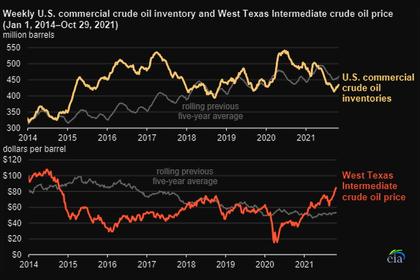
2021, November, 9, 17:20:00
GLOBAL OIL DEMAND GROWTH
This year, demand for petroleum, both in the United States and globally, has largely returned to the pre-pandemic levels in 2019. Demand has grown faster than supply, reducing inventories and contributing to higher prices for crude oil and petroleum products.
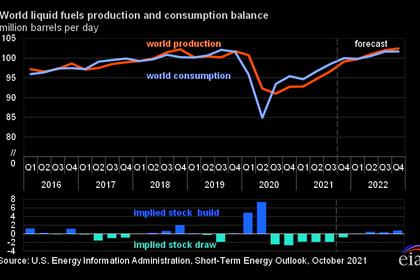
2021, October, 15, 09:35:00
GLOBAL OIL DEMAND WILL UP BY 5.8 MBD
World oil demand is estimated to increase by 5.8 mb/d in 2021, revised down from 5.96 mb/d in the previous month’s assessment.
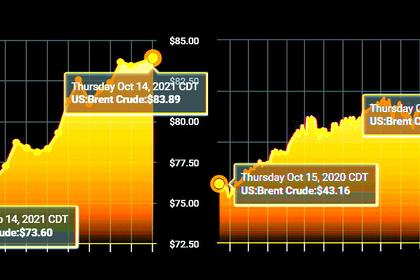
2021, October, 14, 12:55:00
OIL PRICES 2021-22: $81-$72
We expect Brent prices will remain near current levels for the remainder of 2021, averaging $81/b during the fourth quarter of 2021. In 2022, we expect that growth in production from OPEC+, U.S. tight oil, and other non-OPEC countries will outpace slowing growth in global oil consumption and contribute to Brent prices declining from current levels to an annual average of $72/b.
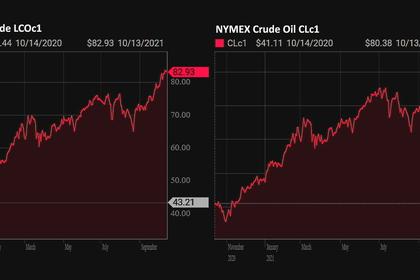
2021, October, 13, 12:20:00
OIL PRICE: NEAR $83 ANEW
Brent was up 1 cent at $83.66 a barrel. WTI fell 50 cents, or 0.6%, to $80.02.
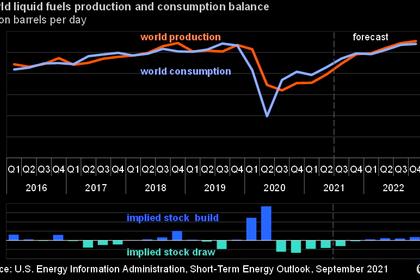
2021, October, 6, 13:25:00
GLOBAL OIL DEMAND WILL UP
"Global oil demand is expected to return to pre-COVID levels towards the tail end of 2022, but the recovery will be uneven. Asia is clearly the driver of growth," IEA Executive Director Fatih Birol said
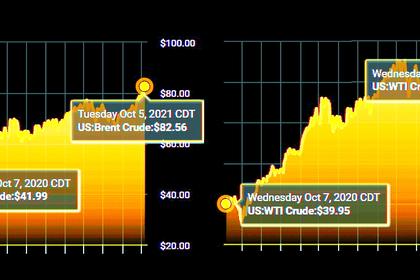
2021, October, 6, 13:20:00
OIL PRICES: $75 - $90
Commodity markets have seen turbulent times in recent months and years. Dated Brent has swung from $85.51/b in October 2018 to $13.24/b on April 2021; its lowest since March 18, 1999.
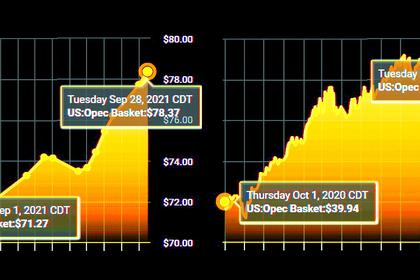
2021, September, 30, 12:05:00
OIL PRICES WILL UP
Dated Brent prices should average somewhere in the upper $70s/b in October and it is quite possible that they may rally during this time,












